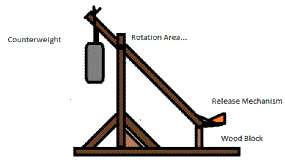Riley Watts, Joe Pozo, Amanda Meyer, and Rowdy Pizer
Table of Contents



A trebuchet is a siege engine that was invented in the Middle Ages either to smash masonry walls or to throw projectiles over them. The word “trebuchet” derives from a Middle French word meaning “overturn”, and its structure comes from an ancient variation of the sling. It is sometimes referred to as a “counterweight trebuchet” in order to differentiate from an earlier weapon that has come to be called the “traction trebuchet” with the original version being pulled by men instead of a counterweight.
The counterweight trebuchet appeared in both Christian and Muslim lands around the Mediterranean in the twelfth century. It could fling up to three-hundred and fifty pound (140 kg) projectiles at high speeds into enemy forts and strongholds. Trebuchets were far more accurate than catapults because the throwing arm was secured to a pivot rod that prevented most side-to-side movement.
The simplest trebuchet is basically a throwing arm pivoted on a fulcrum. On the shorter end of the arm, there is a raised heavy weight (either fixed or hanging), which releases its potential energy when it falls and lifts the sling attached to the other end of the arm. The projectile in the sling is accelerated by being lifted and released at a particular angle depending on the release pin, giving the projectile gravitational potential energy and kinetic energy.
The purpose of our experiment is to find the relationship between the mass of a projectile and its horizontal velocity when launched from a trebuchet.
We believe that the heavier a counterweight is the more velocity it will transfer to the projectile, because heavier objects have a higher potential energy.
Our experiment takes four active users to replicate and because of the unique nature of our trebupult it would most likely take the exact same trebupult to truly replicate the same experiment. We had one member of the group in charge of launching the projectile. That member would raise the counter weight off the ground until the other end of the lever touched a wood block we placed at the base in order to ensure that the counterweight was released from a consistent point. The moment that the counterweight was released the second member of the team would start the timer, and the moment that the projectile, a golf ball, hit the ground they would stop the timer. As soon as the golf ball impacted the ground the third member of our team would mark the spot of the initial impact, while member two would then proceed to measure the distance with a tape measure from the center of the front face of the trebupult. After the distance and the time had been measured we then had the fourth member of the group record the data. We recorded the data in seconds and inches. We would perform this same process for ten trials of each weight. We had five weights ranging from ten to thirty pounds increasing by five pounds with each progressive weight. After all of the data was collected we converted the weight into kilograms and the distance into meters. After converting the data we entered it into an excel spread sheet with the trial number in the first column, the weight in the second column, the distance in the third column, and the time in the fourth column. We then used the distance of each trial and its corresponding time and entered it into the equation in order to find the velocity of the projectile for each trial.

Our results showed us initially that the relationship between the counterweight and the velocity was very linear, but as we reached the higher counter weights the linear relationship began to breakdown. As the weight increased the velocity began to curve as it seemed to approach an asymptote of sorts.


Our experiment was full of fairly insignificant errors due to our uncontrolled environment and human error. These factors consist of problems such as wind and human error in spotting, marking, and timing. But we believe the major sources of potential error came from our trebupult itself. The rotation point of the lever was a bit flimsy and would cause the projectile to fire slightly to the left or right of the path directly in front of the trebupult. Another problem with the trebupult was that the release mechanism would at times cause the trajectory of the projectile to change which could have messed up our ability to accurately measure the velocity of the projectile.
The first thing that came to our minds was that the data was not in full support of our hypothesis. It didn’t support our data because of the curve at the end in relationship to what appears to be an asymptote. After further analysis of the data, the experiment, known information about trebuchets, and laws of physics itself we came across something we had missed. There comes a point when the counterweight has so much more mass then the projectile that the projectile no longer has any bearing on the counterweight allowing it to accelerate towards the ground close to gravity. Since the counterweight can’t accelerate faster than gravity the velocity of the projectile can’t increase anymore either. This is why the graph curves. It curves because it approaches an asymptote that is created by gravity. So what we found was that the velocity of a projectile launched from our trebupult increases in a fairly linear relationship as to its counterweight as it increases, but as when the counterweight starts to approach infinite mass the velocity levels out because the counterweight can’t accelerate faster to the ground then gravity.

"Medieval Siege." Trebuchet. Nov 2000. PBS. 12 Oct 2006 <http://www.pbs.org/wgbh/nova/lostempires/trebuchet/race.html>.
Siano, Donald B. "The Algorithmic Beauty of the Trebuchet" 2006, January 24th <http://www.algobeautytreb.com/>
Carreiro, Paul. "Trebuchet History." 2006. 12 Oct
2006
<http://redstoneprojects.com/catapult_plans_&_instructions.html>
Gardner, Robert. Famous Experiments You Can Do. New York: Franklin Watts, 1990.
<http://www.legionxxiv.org/trebuchetpage>
Geiselman, Kevin A. "Trebuchet Physics." May 2002. 12 Oct 2006 <http://www.tasigh.org/ingenium/physics.html>.
Related Links
http://en.wikipedia.org/wiki/Trebuchet
You can never go wrong with WIKIPEDIA!
http://www.globalspec.com/trebuchet/
This site was just an all around good website for trebuchet stuff. It really helped us understand how it works and what you have to do to make a good one.
http://www.tbullock.com/trebuchet.html
This website helped us understand just all general info on trebuchets. There was so much info that we were able to use from tbullock.com
Just look at the name of this website. It is the king of all trebuchet websites and really helped us understand all kinds of trebuchets.